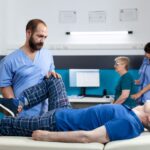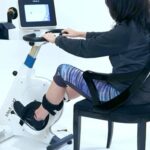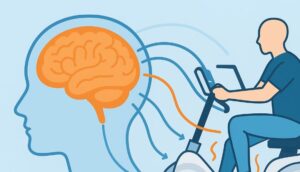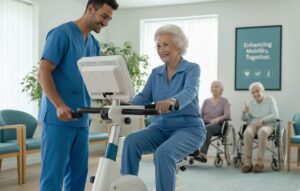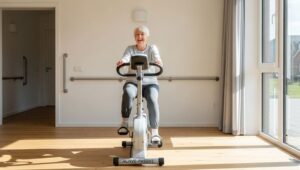
Neuromuscular disorders can be difficult to diagnose, and even more tricky to treat. Although there is no actual cure for a neuromuscular disorder there are some ways to improve strength and mobility, which can lead to an improved quality of life for the patient.
For many years it has been advised that those with a neuromuscular disorder should avoid strenuous activity for fear that their already weakened muscles would be damaged by exercise. However, recent studies are beginning to change that thought process. It is now suggested that a tailored exercise plan can actually help a person to maintain an adequate quality of life despite the physical struggles they may be faced with. This physical activity must be tailored to the individual with consideration for their specific needs in relation to their level of functionality and their diagnosis.
What is a neuromuscular disorder?
A neuromuscular disorder is one that affects how the brain communicates with nerves and muscles, often leading to weakness, spasms, twitching and pain. Because the muscles involved don’t receive enough exercise and stimulation, they often degrade over time.
Neuromuscular diseases are often genetic and have no cure. Although for some it’s possible to identify whether it was inherited or a new gene mutation, it’s also common for the cause to remain unknown.
Neuromuscular disorders are challenging to live with. At Medup, we understand the complexities of the disorder and provide market leading equipment in Ontario, Canada. Whether for at-home or clinical use, contact us to learn more about the Medup V2 Cycle and the health benefits it can provide.
Some examples of a neuromuscular disorder include:
- Amyotrophic lateral sclerosis (Lou Gehrig’s Disease)
- Muscular dystrophy
- Multiple sclerosis
- Myasthenia gravis
- Toxic, small fiber or autonomic neuropathy
- Congenital myopathies
- Lambert-Eaton syndrome
- Spinal muscular atrophy
Exercise can improve mobility in those with neuromuscular disorders
The benefit of physical activity for those with neuromuscular disorders is a relatively new conversation but it’s not hard to understand why it may have merit. When muscles are allowed to sit unused and move into atrophy, they begin to degrade. However, even small, regular movements can encourage muscles to respond to stimulation and maintain or improve its function. This can lead to some significant benefits for the patient, including improved mobility.
Although each patients’ ability and needs will vary quite a bit, there are signs that regular physical activity can help them in a number of different areas, including:
- Reduction in the speed at which the muscle degrades
- Improved movement
- Prolong the onset of diseases like MS
- Prolonged independence
- Reduced risk of falls
- Potential to improve symptoms and reduce related issues
- Improved heart and lung function
- Improved muscle strength, functionality and control
- Reduction of muscle spasms and contractions
- Improved overall quality of life
An Active-Passive Cycle Trainer Provides Huge Benefits
While someone experiencing a neuromuscular disorder is going to be unable to take on the exercise plan that an able-bodied person can handle, there are certainly opportunities that can help them thrive. A portable active passive cycle trainer is one of the best options available for someone that is looking for some physical activity, but has varying levels of ability day to day.
The MedUp V2 bike is a portable at home trainer that can adapt to a wide variety of needs while the built-in features make it an easy addition to any physical exercise routine.

Designed for upper and lower limbs
The included hand grips, securing mitts and leg guide allow the bike to be used however the patient needs it to be, both as a leg cycle and an arm ergometer.
Incorporated spasm recognition software
A significant safety feature, this software recognises when a muscle is spasming and releases it immediately, protecting both the patient and the muscle.
Includes 4 training modes
Whether the patient is able to power the movements themselves or needs the support of an assisted or passive cycle, this unit is catered to them. Even in full passive mode with the motor doing all of the resistance work for the patient, their muscles will see a benefit.
Symmetrical training
Allows the user to adjust the training modes of each side independent to one another, allowing for one side to receive more of a workout that the other. This can result in a more symmetric result.
Approach muscle training with care
As with any health concerns, a change in physical activity should be helmed by a professional. People with neuromuscular disorders are susceptible to some pretty painful side effects if their exercise routine isn’t given the proper consideration. Their condition can often be aggravated by fatigue so it’s highly recommended to keep this in mind as you move forward. Starting with a low intensity exercise for a very short amount of time is going to have much greater positive impact than allowing them to go until they are tired. If pushed too hard someone with a neuromuscular disorder can experience several bad days as a result.
Despite these cautions the benefits that they can experience are well worth the effort. Although there are several methods of physical activity, an active-passive cycle trainer is the perfect option for many. If travelling to a physical therapist’s office regularly is a burden having a unit in your home that provides the same support can make all the difference.
